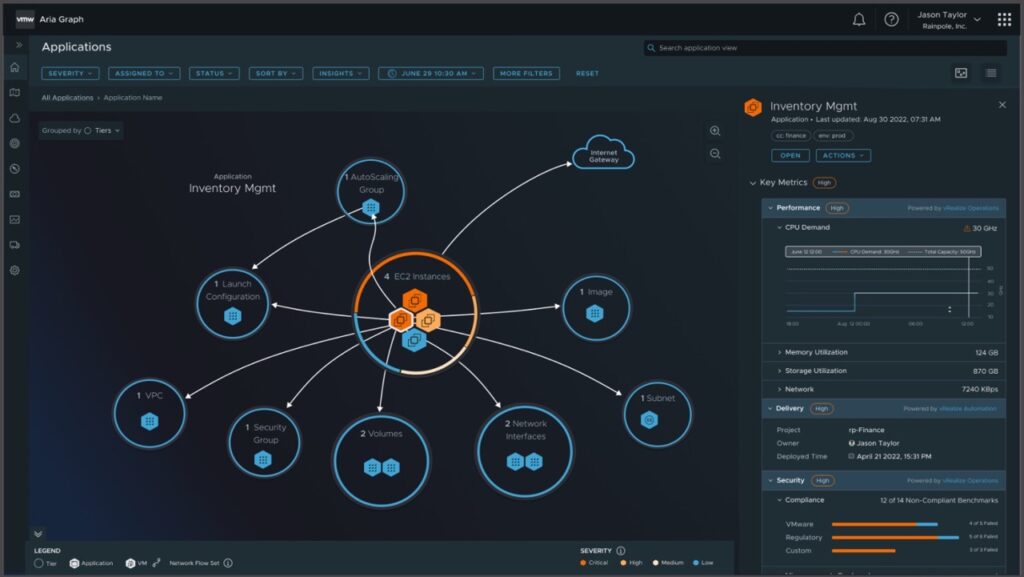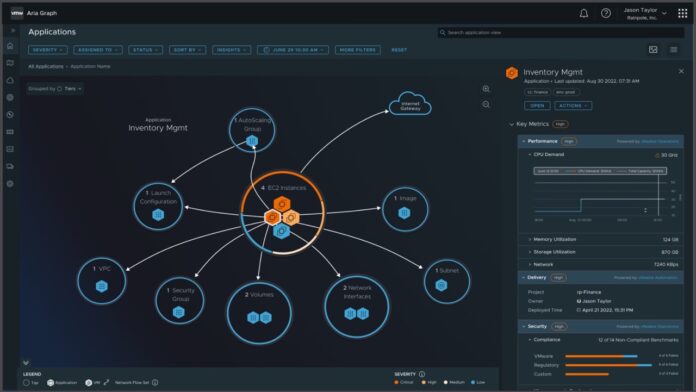Aria combines and expands VMware’s vRealize and CloudHealth products
SAN FRANCISCO – At its VMware Explore event in San Francisco this week, VMware introduced Aria, a new multi-cloud management portfolio to help enterprises manage cloud infrastructure and cloud-native applications. Aria, the new branding for a suite of existing VMware services and some new ones, combined, is aimed at helping businesses manage the cost, guarantee performance, and manage consistent security policies across increasingly distributed cloud computing environments spanning multiple public and private cloud domains.
The centerpieces of the new suite are Aria Graph and Aria Hub, which provide central management tools and a single-pane management interface. Aria Graph, described as “a graph-based data store technology,” provides a near real-time interface that VMware says offers a single source of truth to understand the dynamic changes happening to cloud apps and services.
The goal, said VMware SVP and GM of cloud management Purnima Padmanabhan, is to provide engineering and ops teams with complete visibility using an Application Programming Interface (API)-driven environment to draw all the relevant information together.
“Developers need cost, performance, security, and configuration data — often sitting in disparate tools — to understand the complete characteristics of the application that they are building,” said Padmanabhan.

Aria Graph can be scaled to support hundreds of millions of nodes, said VMware. Its event-based collection system captures change events whenever they happen, and an open architecture supports data aggregation from any source. VMware touts Aria’s unified GraphQL API as a single consistent interface to tap into multi-cloud environments. GraphQL, originally developed by Facebook, is a flexible query language for APIs, often cited as a possible successor to the ubiquitous REST API architecture.
“GraphQL is all about decoupling APIs from their clients by flipping the control and letting the clients determine what the shape of the data should look like. Through this process, the client and the server become more independent pieces of software and much easier to iterate on and maintain,” said VMware.
Aria Hub, previously introduced as Project Ensemble, provides centralized views and controls to manage multi-cloud deployments. The portfolio also adds new cloud governance, migration and insight tools.
“We’ve taken all these complex disciplines and brought them together and integrated them to align to customer outcomes such as cost, performance, security, config, and delivery automation,” said Padmanabhan.
Aria Guardrails, for example, automates networking, security, cost performance and configuration at scale. Aria Migration helps automate the process of assessment, planning, and execution via VMware’s HCX platform. And Aria Business Insights uses AI and ML to drive business insights from the event correlation managed by Aria. Guardrails is coming next month, VMware said. Migration and Business Insights will be available as public preview versions until the full Aria-branded portfolio is ready for prime time in early 2023.
The new suite of services rebrands VMware’s previously introduced vRealize, CloudHealth and Tanzu Observability cloud management tools with new capabilities.

